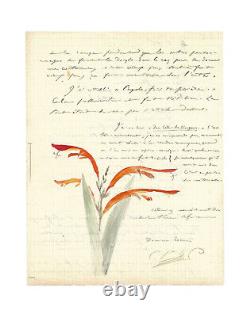
- Homepage
- Author
- Alfred Bruneau (3)
- Anatole France (3)
- Auguste Maquet (3)
- Beydts (louis) (4)
- Camille Mauclair (3)
- Chateaubriand (5)
- Colette (3)
- Ernest Daudet (3)
- Eugène Labiche (3)
- Jean Couty (3)
- Jean-léon Gérôme (5)
- Louise Read (4)
- Marcel Proust (5)
- Paul Chabas (4)
- Paul Meurice (3)
- Proust (3)
- Roger Martin Du Gard (4)
- Salomon Reinach (3)
- Sully Prudhomme (7)
- Violette Leduc (4)
- Other (3947)
- Era
- 18th Century (11)
- 1900 To 1960 (57)
- 1960s (5)
- 1970s (7)
- 19th (5)
- 19th Century (48)
- 20th Century (12)
- Beautiful Era (12)
- Belle Epoque (49)
- First Empire (7)
- First World War (4)
- Nineteenth (18)
- Nineteenth Century (10)
- Post-war (21)
- Restoration (16)
- Revolution (4)
- Roaring Twenties (27)
- Second Empire (21)
- Second World War (5)
- World War Ii (9)
- Other (3674)
- Language
- Region
- Subject
- Theme
Camille Saint-Saëns / Autographed letter with drawing and poem / Ascanio




Saint S" [to Louis Gallet] S. L, February 5, 2 p. In-4 on grid paper Small stain without affecting the text. A very beautiful letter from Saint-Saëns regarding the writing of his opera Ascanio, enriched with a poem from which it is taken - The composer ends his letter by mentioning Don César de Bazan by Jules Massenet and adorns it with an original color drawing representing an African flower. "In the shadow of the black towers In the garden full of roses There pass our loves! Hopes, blooming flowers With a ray from his beautiful eyes. The desired hour is near. O my beloved Dove And my soul is prepared For all the battles to conquer you, Love cannot grow or die anymore! With a ray from his beautiful eyes.
Fill my joyful heart Hope, blooming flowers! In the shadow of the black towers There pass our loves In the garden full of roses! This is the current state of the question, if "Perfume" displeases you, if you find the inversion of the last stanza too decadent, I will return everything to its original state, nothing is easier. This piece did not amuse me to do. There is nothing to say about this man who comes jabbering on stage while the other characters are picking their noses to give themselves a composure, it's old-fashioned, completely old-fashioned, it makes a stain in the act.
I restored "Pagolo, say your prayer." It passes quickly and is very good. The key was not to dwell on it. I saw "Don César de Bazan" yesterday. It's very amusing: I don't understand how they managed to make it boring when they put it in opera-comique [.
] Admire this sample of African flora. Composed in the space of fourteen months, from September 1887 to November 1888, Ascanio consists of five acts and seven tableaux. The libretto is due to the pen of Louis Gallet (this letter is most certainly addressed to him) who had already collaborated with the musician for three of his stage works (La Princesse jaune, Etienne Marcel, and Proserpine); it is based on a drama by Paul Meurice dating from 1852, Benvenuto Cellini, itself inspired by Ascanio, a novel by Alexandre Dumas père written in 1843, which was sourced from the Memoirs of Benvenuto Cellini, first published in French in 1822. The poem in question here is from Act II, tableau III, scene I.
